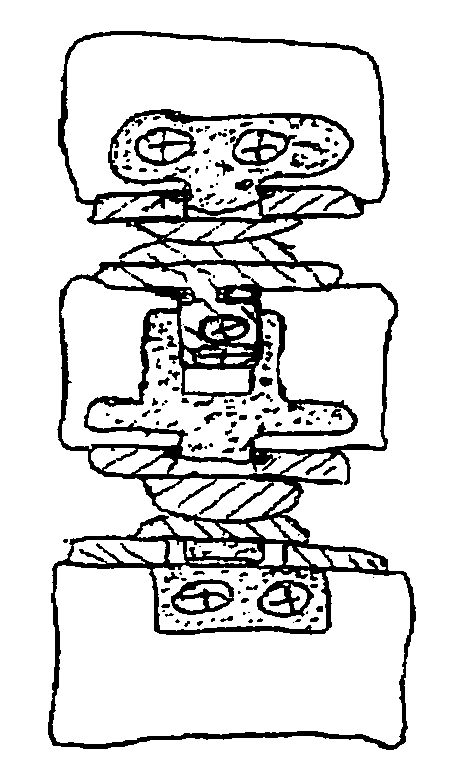Artificial disc replacement (ADR) fixation methods and apparatus
a technology of artificial discs and fixation methods, applied in the field of artificial disc replacement, can solve the problems of reducing the efficiency of disc degeneration surgery, reducing the ability of the nucleus to handle compression load, and reducing the effectiveness of redundant annular fibers in controlling vertebral motion, so as to improve the fit of the patient's vertebrae and facilitate the bending of the adr
- Summary
- Abstract
- Description
- Claims
- Application Information
AI Technical Summary
Benefits of technology
Problems solved by technology
Method used
Image
Examples
Embodiment Construction
[0069]FIG. 1A is an anterior view of an ADR according to the invention and two vertebrae. The narrow areas 102, 104 connect the plate-like components to the ADR EPs facilitates bending the ADR. The screws can be locked into the ADR by C-rings incorporated in the plate-like components. The thin area of the TDR EP, between the intradiscal component and the component on the anterior surface of the vertebra, could be transected. Cutting the TDR EP allows removal of the extradiscal component during revision surgery. Removing the extradiscal component facilitates placement of a TDR at an adjacent level during a subsequent surgery. Alternatively, the strip of metal between the intradiscal and extradiscal components could be replaced with one or more cables. FIG. 1B is a partial sagittal view of the spine and the embodiment of the ADR drawn in FIG. 1A. Note that the upper ADR component 110 has bent to better fit the anterior surface of the vertebra.
[0070]FIG. 2A is an anterior view of the ...
PUM
 Login to View More
Login to View More Abstract
Description
Claims
Application Information
 Login to View More
Login to View More - R&D
- Intellectual Property
- Life Sciences
- Materials
- Tech Scout
- Unparalleled Data Quality
- Higher Quality Content
- 60% Fewer Hallucinations
Browse by: Latest US Patents, China's latest patents, Technical Efficacy Thesaurus, Application Domain, Technology Topic, Popular Technical Reports.
© 2025 PatSnap. All rights reserved.Legal|Privacy policy|Modern Slavery Act Transparency Statement|Sitemap|About US| Contact US: help@patsnap.com



